How to Prepare Your Cat for a New Baby
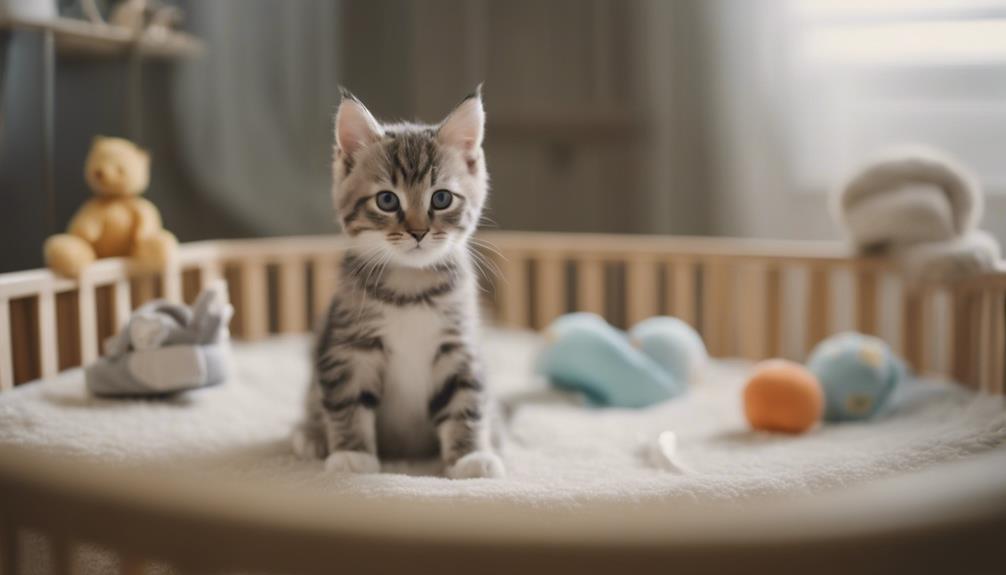
Welcoming a new baby into your home is an exciting time, but it can also be stressful for your feline friend. Cats are creatures of habit and can be sensitive to changes in their environment. To help your cat adjust to the new addition to your family, consider the following tips:
- Gradual Introductions: Allow your cat to become familiar with the scent of the baby before bringing them home. Use items like blankets or clothing that have the baby's scent on them.
- Create Safe Spaces: Set up designated areas in your home where your cat can retreat to if they feel overwhelmed. Make sure these spaces are quiet and cozy, with access to food, water, and a litter box.
- Maintain Routine: Try to stick to your cat's regular feeding and play schedule as much as possible. This will help provide a sense of stability during this time of change.
- Positive Reinforcement: Reward your cat with treats or extra attention when they exhibit calm and relaxed behavior around the baby. This will help create positive associations with the new family member.
- Supervise Interactions: Always supervise interactions between your cat and the baby. Encourage gentle and respectful behavior from both parties to ensure a safe and harmonious relationship.
By following these tips and being patient with your cat, you can help facilitate a smooth transition for your feline friend as you welcome a new baby into your home.
Establish a Safe Space
Creating a safe space for your cat is essential when preparing for the arrival of a new baby. Cats, like many animals, thrive in environments where they feel secure and have their own comfort zone. It's important to provide your feline friend with a designated area where they can retreat to when they feel overwhelmed or stressed.
This safe environment can be a quiet room equipped with their favorite toys, bed, food, water, and litter box. Ensuring that this space is off-limits to the baby will help your cat feel secure and respected.
Gradually Introduce Baby Sounds

When preparing a cat for a new baby, it's essential to gradually introduce baby sounds to familiarize the feline with the new auditory stimuli.
Play recordings of baby noises at a low volume to gauge the cat's reaction and observe its behavior. Providing positive reinforcement, such as treats or affection, during these sessions can help create positive associations with the baby sounds.
Play Baby Noises
To help your cat adjust to the new addition to the family, gradually introduce baby sounds by playing recordings or videos of babies crying and cooing in the background of your daily routine. This noise desensitization technique can assist in preparing your cat for the upcoming changes and help in behavior adjustment. By exposing your cat to these sounds, you are providing valuable training techniques that can aid in reducing stress and anxiety once the baby arrives. Below is a table illustrating the different sounds you can introduce to your cat gradually:
| Sound Type | Description | Purpose |
|---|---|---|
| Baby Crying | Loud, high-pitched cry | Familiarization |
| Baby Coos | Soft, gentle sounds | Comfort and reassurance |
| Baby Babbling | Incoherent babbling | Acclimation to baby talk |
Monitor Cat's Reaction
Introducing baby sounds gradually can help pet owners observe and understand their cat's reactions to prepare them for the arrival of a new baby. Pay close attention to your cat's body language and stress signals when exposing them to recordings of baby noises.
Cats may display signs of agitation, such as flattened ears, dilated pupils, or a twitching tail, indicating discomfort or stress. Conversely, some cats might show curiosity or indifference, which can signify a more positive response.
Offer Positive Reinforcement
Gradually introducing baby sounds to your cat can be a positive way to acclimate them to the upcoming changes in the household dynamics. Training techniques such as playing recordings of baby noises at a low volume and gradually increasing it over time can help your cat adjust to the new sounds they'll encounter.
Implementing a rewards system by offering treats or extra playtime when your cat remains calm during these sessions can reinforce positive behavior. Behavior modification through encouragement methods like petting and soothing words when your cat reacts calmly to the sounds can also be effective.
Maintain Routine and Attention
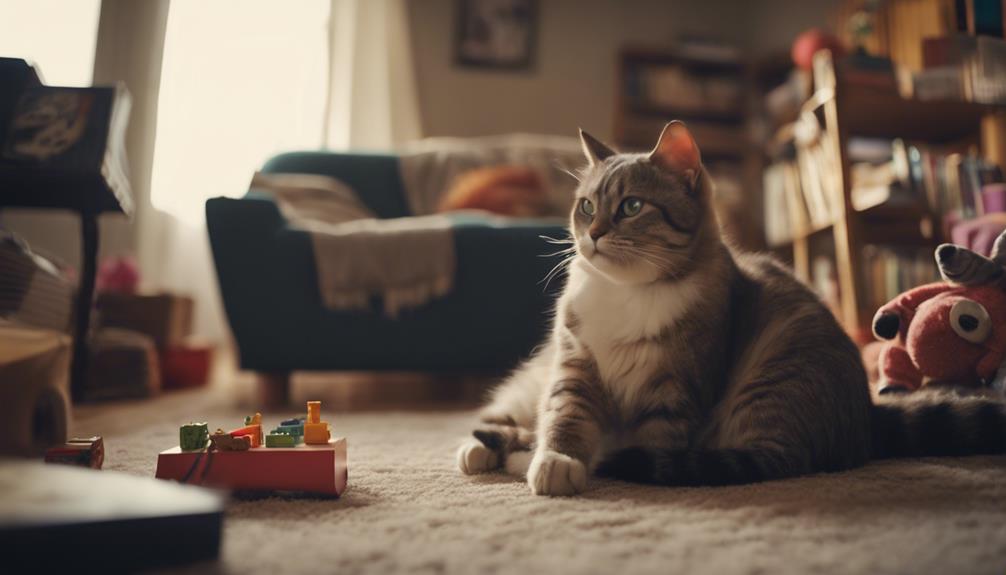
Maintaining your cat's routine and ensuring they receive attention are crucial aspects to consider when preparing them for a new baby. Cats thrive on consistency, so sticking to their usual feeding times and play routines can help them feel secure during the changes.
Balancing your attention between your cat and the new baby will help prevent feelings of neglect and jealousy.
Routine Consistency
Consistency in your cat's daily routine is key to helping them adjust smoothly to the arrival of a new baby. Cats thrive on predictability, so maintaining their routine amidst upcoming changes is crucial. To ensure a seamless transition, consider the following tips:
- Stick to Regular Feeding Times: Keep meal times consistent to provide your cat with a sense of stability.
- Maintain Playtime: Dedicate specific periods for play to prevent feelings of neglect.
- Scheduled Cuddles: Allocate time for cuddling and bonding to reassure your cat of your continued affection.
- Consistent Bedtime: Maintain regular bedtime routines to promote a sense of security and comfort.
- Environmental Stability: Minimize changes in the living environment to help your cat feel secure and grounded.
Attention Balance
To ensure a smooth adjustment for your cat when preparing for a new baby, it's vital to find a balance between maintaining their routine and providing them with adequate attention.
Parental preparation plays a crucial role in this process. Implement bonding techniques that involve both the cat and the new family member to foster positive interactions. By gradually adjusting the cat's routine to align with the upcoming changes, behavior adjustment becomes more manageable.
Provide Vertical Escape Options
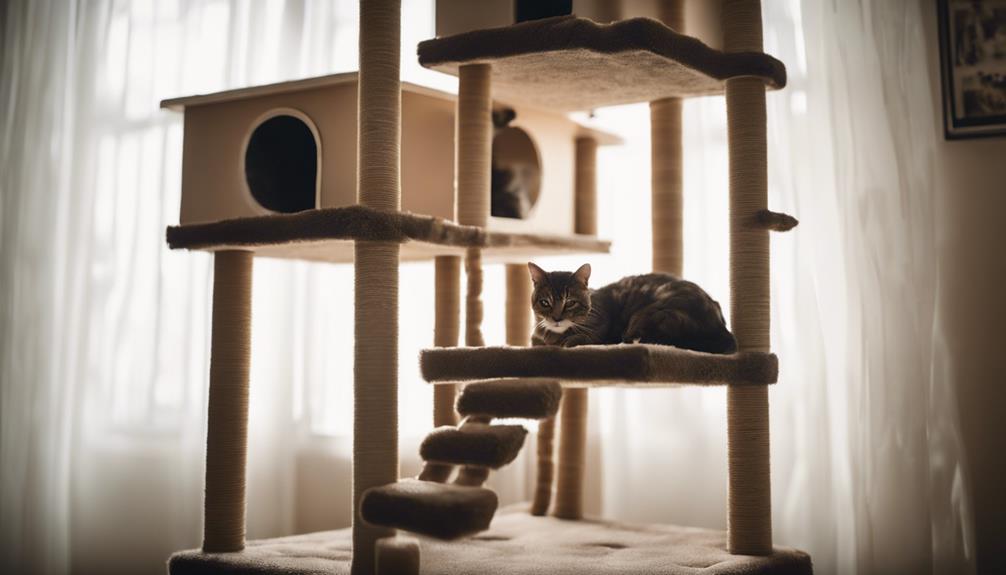
Consider providing tall shelves or cat trees to give your feline companion vertical escape options when acclimating to the new baby. Cats often seek elevated spaces for comfort and security, especially when feeling overwhelmed by new situations. Here are some suggestions to help create vertical space for your cat:
- Install cat shelves: Placing shelves at different heights around your home can give your cat multiple options to climb and perch.
- Set up window perches: Cats enjoy looking out windows to observe their surroundings, so providing a secure perch by a window can offer both a high vantage point and entertainment.
- Invest in a cat tree: Cat trees with various levels and hiding spots can serve as a retreat for your cat when they need a break from the hustle and bustle of a new environment.
- Consider wall-mounted platforms: Wall-mounted platforms can provide additional vertical territory for your cat to explore and relax.
- Include cozy beds or blankets: Adding comfortable bedding to these vertical spaces can make them even more inviting for your cat.
Familiarize Cat With Baby Gear
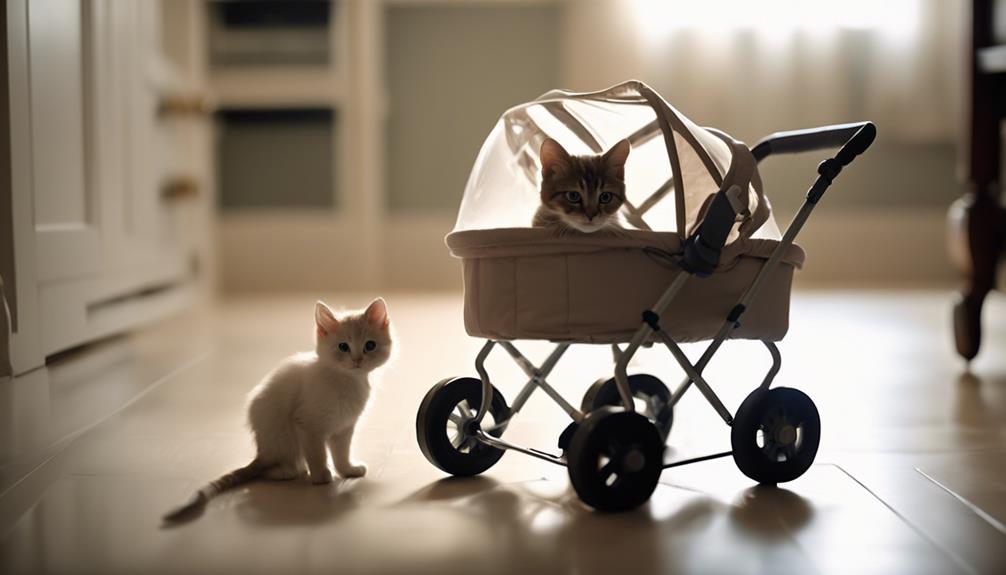
When introducing new baby gear to your cat, gradually familiarize them with the items in a calm and reassuring manner. Start by allowing your cat to explore the baby gear at their own pace. Place the gear in areas your cat frequents, ensuring they can investigate without feeling pressured. Introduce the baby's toys gradually, allowing your cat to sniff and become accustomed to their scent. This will help your cat associate the new items with positive experiences.
To prepare your cat for their new sibling, engage in bonding activities that involve both your cat and the baby gear. Encourage positive interactions, such as playing near the baby gear or offering treats when your cat is around it. This will help your cat develop a positive association with the new items and create a sense of familiarity.
Seek Veterinary Behavior Advice

Seek advice from a veterinary behavior specialist to address any concerns about your cat's adjustment to the new baby. A professional can provide guidance on behavior modification techniques and recommend pheromone therapy to help your cat adapt smoothly to the upcoming changes.
Here are some key points to consider when seeking veterinary behavior advice:
- Behavior Evaluation: The specialist will assess your cat's current behavior and suggest strategies to prevent any issues that may arise with the new baby.
- Environment Enrichment: Recommendations on enriching your cat's environment can help reduce stress and promote positive behaviors.
- Introduction Techniques: Learn how to properly introduce your cat to the new baby and create a safe space for both.
- Training Tips: Training exercises can help prepare your cat for the new routines and interactions that come with a baby.
- Follow-up Support: Establish a plan for ongoing support and follow-up consultations to address any additional concerns that may arise during the transition period.
Monitor Interactions Closely
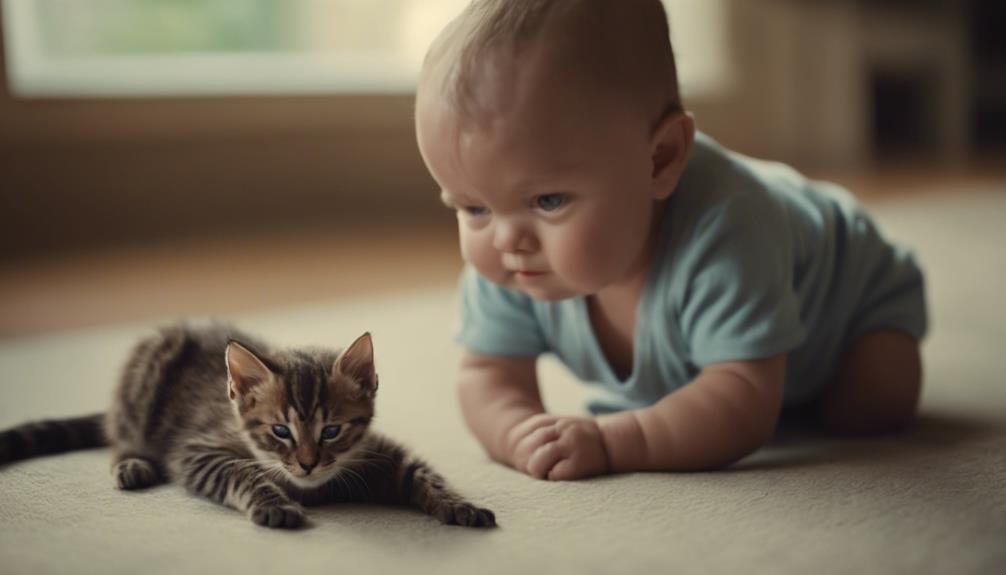
Carefully monitoring interactions between your cat and the new baby is crucial for ensuring a safe and harmonious environment for both. Pay close attention to your cat's body language cues and behavior changes when they're around the baby. Signs of stress or discomfort may include flattened ears, dilated pupils, hissing, or avoiding the baby altogether. If you notice any concerning behaviors, consider consulting a veterinary behaviorist for guidance on how to address them effectively.
To help facilitate positive interactions, consider implementing play therapy as a stress reduction technique for your cat. Engaging in interactive play sessions with your cat can help alleviate any tension or anxiety they may be experiencing due to the new addition to the family. Additionally, creating safe spaces for your cat to retreat to when they need a break from the baby can also be beneficial in reducing their stress levels.
Frequently Asked Questions
How Can I Prevent My Cat From Scratching the Baby's Belongings?
To prevent scratching on the baby's belongings, consider using scratch prevention techniques like providing appropriate scratching posts and toys, training your cat with positive reinforcement, and using deterrent options such as double-sided tape or citrus scents on the items.
What Are Some Signs That My Cat Is Feeling Stressed or Anxious Around the New Baby?
Noticing stress indicators in a cat around a new baby is crucial. Behavior changes like hiding, excessive grooming, or aggression can signal anxiety. Watch for signs such as dilated pupils, flattened ears, or tail twitching.
Should I Be Concerned if My Cat Starts Avoiding Me After the Baby Arrives?
If a cat starts avoiding their owner after a new baby arrives, it could be a sign of stress. Understanding cat behavior and communication cues is essential. Observing feline body language can provide insight into their feelings and help address any issues.
How Can I Help My Cat Adjust to the New Routine and Schedule With a Baby in the House?
Helping a cat adjust to a new routine with a baby involves gradual introductions, supervised interactions, and maintaining their socialization. Patience and consistency are key in creating a harmonious environment for both the feline and the infant.
Are There Any Specific Toys or Activities I Can Provide to Help Keep My Cat Entertained and Engaged During the Transition Period?
Interactive toys provide enrichment and mental stimulation for cats. Puzzle feeders can engage their minds and keep them entertained during transitions. These activities help cats adjust and thrive in new routines, ensuring their well-being.











